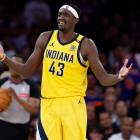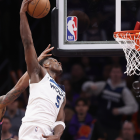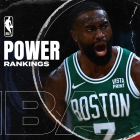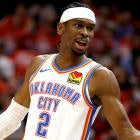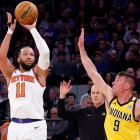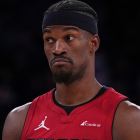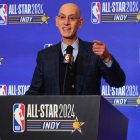The NBA's hyped season-opening game between the Cleveland Cavaliers and Boston Celtics was derailed within a few minutes. New Celtics star Gordon Hayward went up for a lob, bumped into LeBron James in mid-air and landed awkwardly. The result was a gruesome lower leg injury that the Celtics are calling a dislocated ankle and fractured tibia.
To get a better understanding of Hayward's injury and what lies in store for him during his recovery, CBS Sports spoke with certified athletic trainer Jeff Stotts. In addition to his work in the field, Stotts runs his own website, InStreetClothes.com, and serves as an injuries analyst for CBS Sports partner Rotowire.com.
CBS: Ankle dislocation and tibia fracture is what they're calling it. And obviously, tibia fracture (a broken shinbone) makes sense. That's clear to people. But for the dislocation … you have the three bones -- the tibia, fibula and talus -- that make up the ankle joint. What exactly do we mean when we say it dislocated?
Jeff Stotts: So based on the pictures we saw, you can see the talus slipped out from underneath the ankle mortise of the tibia and fibula, the kind of roof that those two bones form over what we consider the ankle joint. Likely in that process is where the bone broke. Right now all we know is tibia, we don't know if there's any damage to the talus. And then they haven't described any soft-tissue injuries that likely occurred. Because to have something so violently forced into that direction, you know you have stabilizing ligaments to try and prevent that, but if it was out, and stayed out like it reportedly did, until they reduced it, you're looking at some level of soft tissue damage. We just don't know to what extent yet.
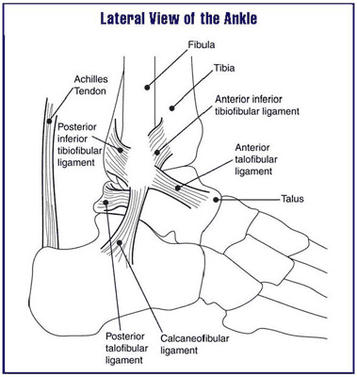
CBS: You mentioned how they reduced (set the ankle back in place) it right there on the court. Is that a good sign they were able to do that immediately?
JS: Yeah, I mean it's important to do it early. You want to make sure the vascular structures (nerves, arteries) that run in close proximity to the tibia in that area aren't compromised. The ankle is one of those joints that's a little harder to relocate than a finger, or you know a lot of times shoulders go back into place relatively easily. The ankle can be difficult, but that's why they have the doctors come to the games.
But it will also provide some pain relief for Hayward. The guy, obviously reacted when it occurred, but by the time they were carting him off the floor, he was pretty stoic. For a guy that had this catastrophic, gruesome looking injury, I was pretty impressed with his composure.
CBS: In regards to the soft tissue injuries you mentioned earlier, Mike Gorman, the Celtics broadcaster, reported that sources told him it was a clean fracture, with no ligament or blood vessel damage. If that is indeed true, why is that good news for Hayward?
JS: Connective tissue can take a long time to heal, especially if it's repaired. It's one reason why a broken bone sounds worse than a torn ACL, but you have to go in and repair that ligament. Connective tissue, once it's past a certain point, it's hard to get it back to its original strength, it takes time, and often requires surgical intervention.
If he did avoid ligament damage, the potential for there not being an ankle reconstruction on the lateral aspect or medial aspect as well is good. They don't have to worry about reconstructing those ligaments. They can just worry about aligning the pieces of bone and making sure they're stable to allow for a proper union of the bone fragments.
CBS: To help with that do you think they'll have to put in any plates or hardware?
JS: It's very likely they're gonna put plates and screws. It's a little bit different than the Paul George thing where they put the rod in the middle because you just want to stabilize the injury site. Here you're talking about, because of the dislocation, because of the forced rotation of the bones, likely using a plate and screws to stabilize any of the area. Again that's purely speculation. There might be some other steps involved depending on the severity of the injury. Those are the little specifics we're trying to clear up and see what they end up doing.
CBS: Do you think it will be harder for Hayward to come back from this injury because he's a basketball player? Or, to put it a different way, do you think Hayward being a basketball player will make his return harder than if he played football or baseball where there isn't as much jumping?
JS: Yeah, definitely. The ankle is key. You make hard cuts, he plays a position that has a high demand of lateral movement, so those areas are gonna be stressed. There's a reason the ankles are the No. 1 injured body part in the NBA. Ankle sprains are way up there, and it's because they're vulnerable, they're exposed in the sport. It's a problematic area.
He's likely gonna need to spend some time focusing on something like proprioception to make sure the areas in the body are responding accordingly to manage any kind of additional stress that will eventually be applied to them. It's gonna take time. It might sometimes be a simple injury, but it also can be a complex recovery that they'll break up into stages to try to work him back.
CBS: Speaking of that recovery ... Of course, everyone is different, but from your experience working with athletes, do you think it will be harder for Hayward to return physically or to be OK mentally with flying through the air like that again?
JS: It's a little bit a both, right? Mental health is a big thing, and that's gonna be something he has to address, in terms of being back on the court and feeling comfortable. Those two go hand in hand, mental approach and physical approach. Luckily, by all accounts, Hayward is a mentally tough guy. He's surrounded by a good medical staff in Boston. He's gonna have plenty of resources at his disposal to get back, and he's a guy that's been commended for his offseason approach, too.
Mentally, I'm not worried about Hayward. Are there going to be challenges? Yes, but I think he's surrounded by ... and again you know that familiarity with (Celtics coach Brad) Stevens will help because they have a history there. He's surrounded by the appropriate resources to make a full recovery.
CBS: I know you aren't a surgeon, but Kobe Bryant advised advising Hayward to be "doing everything in your power to prepare for surgery, ask all the questions to be sure you understand fully the procedure so that you may visualize it in your subconscious" Do you think there's any truth to that being helpful?
JS: I like the athletes that ask questions. You want them to be informed, because, we talked about that mental aspect of it. It helps them be involved in the process. A lot of these guys are habitual and meticulous with their approach to rehab and working out generally even when they're healthy. They want to know why they're doing it.
Steve Nash is a guy that was always on point with, he knew everything about his injuries, biomechanically, just hearing him talk about his injuries. Kobe was the same way. Those guys, the more information you have, it's gonna make things easier to report. You know if you see something pop up, "Oh hey, I'm feeling this. Or, this doesn't feel right, could it be this?" It's open dialogue between everybody involved medically and the player himself because nobody is gonna get as much information as the player, because they're listening to their body.
CBS: Lastly, what's a best-case scenario here for Hayward in terms of coming back?
JS: It's difficult to speculate given there's still so many unknowns. But I think it's likely gonna be 12 weeks at least based on what we have right now. He'll probably be evaluated at that mark. There's an outside chance he's able to play again this season, but again the only other example I have in my database, the injury occurred in November and the player missed the final 68 games recovering. He's going to be up against it.
Is it a career-ending injury? By no means, from what we can tell. But he's gonna be hard-pressed to get back this season. And just because, again, it's an injury of high magnitude, you want to make sure he's returning at 100 percent and not running the risk of some secondary injury or some other setback.














